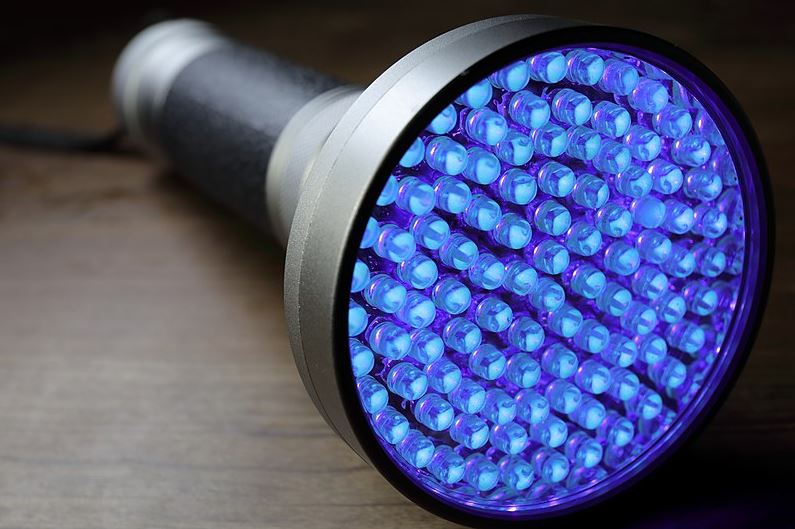UV flashlights and black lights are often used interchangeably, but are they really the same thing? While both emit ultraviolet (UV) light, there are subtle differences that set them apart. Understanding these distinctions is crucial for those seeking specific applications, whether it be detecting counterfeit currency, highlighting pet stains, or uncovering hidden messages. In this article, we will delve into the world of UV technology to decipher the dissimilarities between UV flashlights and black lights and shed light on their distinct purposes and functionalities.
What is a UV flashlight?
UV flashlights, also known as black lights, are handheld devices that emit ultraviolet (UV) light. Unlike standard flashlights that produce visible light, UV flashlights emit a specific wavelength of light that falls outside the range of human vision. This unique characteristic makes them extremely versatile in various applications ranging from forensic investigations to leak detection and even scorpion hunting. The concept of UV light dates back to the early 1800s when it was first discovered by German physicist Johann Wilhelm Ritter. Since then, scientists and researchers have been intrigued by its ability to reveal hidden details and substances that are otherwise invisible to the naked eye.
How does a UV flashlight work?
Unlike traditional flashlights that produce visible light, UV flashlights emit a high-frequency light that falls just outside the range of human vision. These specialized devices have gained popularity in various fields such as forensics, pet detection, and counterfeit detection due to their ability to unveil hidden details and substances invisible to the naked eye.UV flashlights operate by utilizing specific wavelengths within the ultraviolet spectrum, typically around 365 nanometers (nm) or 395 nm. This wavelength range is commonly referred to as UVA or blacklight.
Applications of UV flashlights
Have you ever wondered if there is a way to detect hidden stains or trace evidence that are invisible to the naked eye? Look no further than the UV flashlight. This compact and powerful tool has gained popularity in recent years due to its ability to reveal hidden substances and illuminate objects that are otherwise imperceptible under normal lighting conditions. Whether you’re a homeowner looking for a reliable tool for cleaning or a forensic investigator searching for clues at a crime scene, this article will explore the uses, features, and benefits of UV flashlights, shedding light on why they have become an essential gadget in various fields.
Safety precautions when using a UV flashlight
The naked eye may not be able to detect hidden stains, germs, or other potentially harmful substances lurking on surfaces. This is where the UV flashlight comes into play. A revolutionary tool that harnesses the power of ultraviolet light, the UV flashlight has gained popularity for its ability to unveil hidden messes and reveal what lies beneath. In this article, we will explore the uses and benefits of a UV flashlight, how it works, and how it can make a significant difference in maintaining cleanliness and safety in various settings. Get ready to discover a whole new level of visibility with this game-changing device!
Factors to consider when purchasing a UV flashlight
These compact devices emit ultraviolet light, which has a shorter wavelength than visible light and is commonly used for a variety of applications. From forensic investigations to counterfeit detection, pest control to mineral identification, UV flashlights have proven to be an indispensable tool in various industries.The power of UV light lies in its ability to make certain substances glow or fluoresce, revealing hidden details that are invisible to the naked eye. This unique property allows investigators to uncover crucial evidence at crime scenes by highlighting bodily fluids or fingerprints that may have otherwise gone unnoticed.
Examples of popular UV flashlights on the market
These compact handheld devices emit ultraviolet light, which is invisible to the naked eye but has the remarkable ability to illuminate substances and objects that would otherwise remain unseen. From detecting counterfeit money and identifying bodily fluids at crime scenes to uncovering hidden stains on hotel sheets or scorpions during a nighttime hike, UV flashlights have proven themselves invaluable in a wide range of scenarios. This article will delve into the fascinating world of UV flashlights, exploring their various applications, functioning principles, and key features that make them an essential tool for numerous professionals and hobbyists alike.
Conclusion:
Have you ever wondered about the hidden secrets that can only be unveiled under ultraviolet (UV) light? Whether it is detecting counterfeit money, inspecting crime scenes, or exploring the mesmerizing world of fluorescence, a UV flashlight is a powerful tool that allows us to see beyond what meets the eye. In this article, we will delve into the intriguing realm of UV flashlights, exploring their mechanism, applications, and the fascinating wonders they reveal. So grab your UV flashlight and get ready to unlock a whole new dimension that lies in plain sight!

